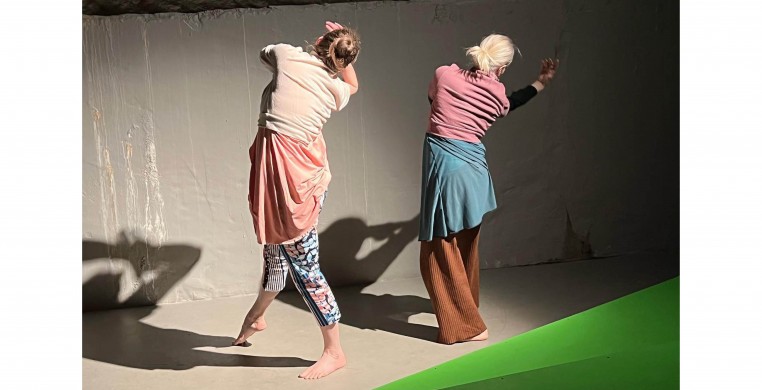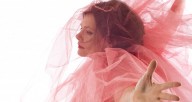UPDATE: The new seechicagodance.com will launch March 31st. Click here to learn more.
“Not Dead Yet” (and alive and well) at SITE/less: Zephyr’s shared evening of experimental performance
Zephyr, an experimental dance company and Chicago arts mainstay, made its return to live, in-person performance at SITE/less with “Not Dead Yet,” a shared evening of new work by Michelle Kranicke (Zephyr), Joanna Read (Same Planet Performance Project), and Tom Brady (Sartori). Each piece was centered—literally and figuratively—around David Sundry’s architectural installation, which was originally developed for Zephyr’s 2019 work titled, “On Notice.” The scenic design maintained its structure: elongated, lime-green, runways that bloom into towering halfpipes on each end, and reignited its capacity to rethink the connection between movement and architecture.
The massive structure occupied most of the performance space; coaxing audience members to skirt its edges upon arrival. Backs pressed politely against walls, shoulders leaned timidly against sides of the installation’s frame; heads cocked, torsos gently twisted, (a few) butts rested in seats, (many) curious eyes surveyed the landscape, which included Kranicke in the midst of what appeared to be a perpetual task:
Finger to tongue.
Small lick.
Careful to only grab one sheet of colorful tissue paper.
Shift left.
Toss left (with force).
Catch right.
Bow forward to make space for an around the back pass.
Repeat.
Toss left, catch right, ‘round the back, repeat… Toss left, catch right, ‘round the back, repeat…
Kranicke seemed completely undisturbed by people entering, talking, laughing, watching (and not watching) her. Beads of sweat pooled and glistened across her cheekbones as more pockets of red, purple, blue and white tissue littered the space below. I was curious how long she had been in this sequence before we arrived, and wondered how long she would continue now that we were there.
Eventually, Kranicke’s rhythm sped up and an emphasis switched from lofty tosses to urgent catches. Richard Norwood’s lighting design sharpened, enveloping Kranicke in an overhead spot, and cued the audience into a collective silence. This familiar “the show is about to start” hush of sustained anticipation and common focus felt pleasantly at odds with the fact that Residual Moments, choreographed by Kranicke with movement development and performance by Kranicke, Joanne Barrett and Molly Strom, had (presumably) already begun.
As the tissue paper task unraveled and Kranicke’s costume, designed by Vin Reed, also shed a layer, Barrett and Strom entered the scene. The pair ignited the architecture with a rapid series of gestures and locomotive short phrases that repeated and continued to fold into themselves anew. Barrett and Strom were both precise and playful—softening the edges between improvisation and sporadic unison as they traversed the runways and expertly navigated between static, reluctant, and mobile, or eager audience members. They patiently and nonverbally cleared space against a side wall with a slow, deliberate walk before slumping downwards into an inverted diagonal slant: head to floor and soles of feet to wall.
The pair’s sponge-like feet absorbed the concrete with each synchronized step; flowing like liquid breath behind Kranicke, who conversely seemed to be withholding exhales. Kranicke stood still but not at rest with her back to Barrett and Strom. Her eyes expanded; so much so that they tugged her jaw downwards and stretched her cheeks outwards. Her lips strenuously separated, gradually revealing teeth.
“Blue skies smilin’ at me.”
Kranicke widened her smile as Willie Nelson’s voice poured into the air. She scanned her head unhurriedly from side to side.
“Nothin’ but blue skies do I see.”
Her exaggerated expression transformed laboriously into a silent slow motion laugh.
“Bluebirds singin’ a song. Nothin’ but blue skies from now on.”
This was one of many delightfully surprising moments of fragmented/non-linear cohesion in Residual Moments. The trio was full of subtle motifs; established and fractured relationships—spatial, temporal and otherwise; rhythms that dissipated almost as quickly as they formed; and repetitive gestures that built patterns—sometimes, seemingly only in order to break them. Kranicke, Barrett, and Strom carried forward these ephemeral associations with a remarkable attunement to one another’s impulses as well as a deep sensitivity to the physicality of their surroundings (human and otherwise). The relationship between their interactions with each other and with the structure made it near impossible to view the architecture as anything short of a collaborator.
Next up was Read’s Things Hidden and Left Unsaid (stage 1), a repurposed version of her full-length work scheduled to premiere in fall 2022 that features additional movement material and performance by Enid Smith, Patrick Burns, Chloe Michels, and Juli Farley. Costumed in matching pink monochromatic sweat suits and armed with a propensity for drama, the quartet exaggerated randomness without ruling out the potential for pattern development. In a realm of abstraction, it was refreshing to be reminded that sometimes a runway can indeed be a runway. Burns exemplified this playful reality with brisk, hip-swaying struts that bounced between platforms with clear direction but without a perceivable destination.
Burns later joined forces with Farley for a virtuosic duet of sprints, slides, dives and spirals across, over and under the interwoven, lime-green aisles. Their weighted strides and audible breath demanded attention; however, I was preoccupied with Smith and Michels’ measured sequencing. Conversely, this pair traveled from end to end of a single runway. They paddled from back to front feet with their arms stretched horizontally outwards, open palms pulsating from slight contractions of the chest. When they came face-to-face with lime-green, their skulls grew heavy and tipped back into a luxurious arch; revealing their foreheads to those behind them before seamlessly repeating the sequence in the opposite direction. Smith and Michels’ relative calm and intimate proximity made a stark, compelling contrast with the neighboring duet of explosive risk and exhaustive rigor.
The final two works of the evening, Gone and Siege, were by prolific composer, sculptor, photographer, choreographer and media arts innovator, Tom Brady. Craving a fresh vantage point, I walked to the other side of the room before Gone began. Strands of thick, black rope with sizeable loops at their ends hung over a halfpipe. The material was within reach of a motionless Brady who laid on top of the same narrow peak; his legs and arms tightly embracing either side of the apex.
Norwood cut the lights. I thought I could still see a silhouetted Brady, but after some time in the dark, I was unsure if this was true or if it was just a memory my eyes reproduced. As visibility returned, Brady’s original soundscape (edited by Norwood) amplified. Pre-recorded spoken word seemed to dictate Brady’s thoughts as he navigated the pulley system of ropes in a visibly effortful descent.
Synthesizers marked a break from the ropes as Brady’s hands, no longer entangled, exploded into a relentless tremor. His fingertips vibrated as moth’s wings do; fluttering around and over his face as he knelt in the center of a runway. The gesture continued—vibrating through an encroaching darkness. At last, Brady’s shadow stabilized into relative stillness. He exited in the blackout without a bow.
Siege, in solo form when I saw it (and with Brady’s longtime collaborator, Monica Newsam, for the other performances), closed the show. Brady returned to the lime-green runway, this time with a piece of loose red fabric that he wrapped, wringed, dragged, caressed, carried and threw. Another blackout stiffened the audiences’ attention and provided cover for Brady’s clothing change from all-black to all-white.
The soundscape—another Brady original edited by Norwood—rapidly escalated with an accumulation of footsteps/horse hooves and a sudden gunshot. Then another… and another. Sirens followed. At this point, Brady was far beyond my sight, covered by ramps and truncated by scattered backs of heads, all straining to see. Explosive noises resembling a bombing further intensified the roaring audio. I could only see a dismembered, bare, foot with an extremely active, outstretched big toe. I wondered what else was happening but was satisfied seeing the room shift. Notably, this was the most mobile the audience had been all evening (we heard the violence, show us the guts). Brady’s feet thrashed before Norwood thrust us into another blackout.
When some light returned, Brady was enmeshed in a set of white ropes that draped over a different halfpipe. I looked to the ramp from Gone to confirm the black ropes were still there. I joined audience members inching towards the center of the architecture and caught a few glimpses of Brady suspended once again from a sloping, lime-green surface. He epitomized the architectural installation for both Gone and Siege; rendering the structure inseparable from the movement.
“Not Dead Yet” was as unrushed as it was unpredictable—a captivatingly satisfying combination. The evening both embraced and resisted feats of virtuosity, teetering between extremes. No viewpoint was the same and no space was out of bounds. The evening was not a sit-down-and-never-meet-again experience. It was a stand-up-the-whole-time kind of durational relationship that required commitment and endurance from both performers and viewers. After all, living (dying) takes patience.


